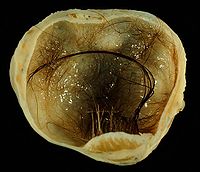
Photo from wikipedia
Background: Tumor pathology can assess patient prognosis based on a morphological deviation of tumor tissue from normal. Digitizing whole slide images (WSIs) of tissue enables the use of deep learning… Click to show full abstract
Background: Tumor pathology can assess patient prognosis based on a morphological deviation of tumor tissue from normal. Digitizing whole slide images (WSIs) of tissue enables the use of deep learning (DL) techniques in pathology, which may shed light on prognostic indicators of cancers, and avoid biases introduced by human experience. Purpose: We aim to explore new prognostic indicators of ovarian cancer (OC) patients using the DL framework on WSIs, and provide a valuable approach for OC risk stratification. Methods: We obtained the TCGA-OV dataset from the NIH Genomic Data Commons Data Portal database. The preprocessing of the dataset was comprised of three stages: 1) The WSIs and corresponding clinical data were paired and filtered based on a unique patient ID; 2) a weakly-supervised CLAM WSI-analysis tool was exploited to segment regions of interest; 3) the pre-trained model ResNet50 on ImageNet was employed to extract feature tensors. We proposed an attention-based network to predict a hazard score for each case. Furthermore, all cases were divided into a high-risk score group and a low-risk one according to the median as the threshold value. The multi-omics data of OC patients were used to assess the potential applications of the risk score. Finally, a nomogram based on risk scores and age features was established. Results: A total of 90 WSIs were processed, extracted, and fed into the attention-based network. The mean value of the resulting C-index was 0.5789 (0.5096–0.6053), and the resulting p-value was 0.00845. Moreover, the risk score showed a better prediction ability in the HRD + subgroup. Conclusion: Our deep learning framework is a promising method for searching WSIs, and providing a valuable clinical means for prognosis.
Journal Title: Frontiers in Genetics
Year Published: 2023
Link to full text (if available)
Share on Social Media: Sign Up to like & get
recommendations!